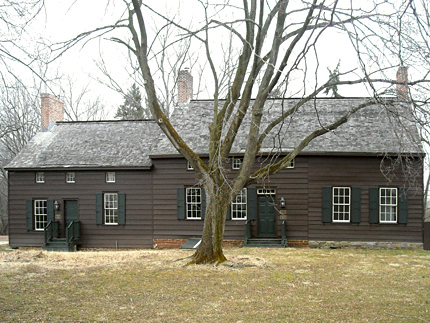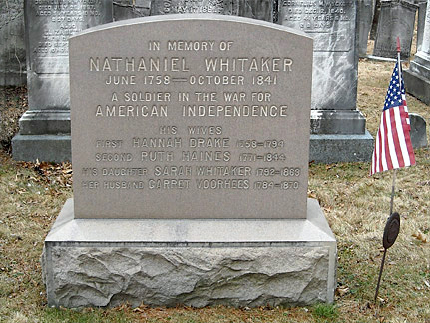



Washington Route Markers
• Rte. 202 / 206 and Washington Valley Rd.
• 254 Rte. 202 / 206
Map / Directions to these Washington Route Markers
Map / Directions to all Bedminster Revolutionary War Sites
Following their victory at the Battle of Princeton on January 3, 1777, General George Washington and his army went to Morristown for winter quarters, where they arrived on January 6. A series of thirteen markers can be found in New Jersey tracing Washington's army's route from Princeton to Morristown. Two of these markers are located in Bedminster. One is a boulder plaque at the corner of Route 202/206 and Washington Valley Road, in front of the shopping center containing an A & P. The other is a marble marker 100 yards from the first, behind a small white fence in front of the offices at 254 Route 202/206. [1]
The other eleven markers in this series can be found in Princeton, Kingston, Griggstown, Bridgewater, Somerville, Bernardsville, Basking Ridge, Harding Township and Morris Township. For a map tracing the route of all thirteen markers from Princeton to Morristown, click here.



Jacobus Vanderveer House
3055 River Road Park (Off Rte. 202/206)
(Just before the exit for River Rd.)
Map / Directions to the Jacobus Vanderveer House
Map / Directions to all Bedminster Revolutionary War Sites
For more information about the Jacobus Vanderveer House
and the Pluckemin Artillery Cantonment,
as well as tours and upcoming events,
see the
Jacobus Vanderveer House website
.
The Vanderveers were a prominent family in Bedminster Township in the 1700's through the mid 1800's. Jacobus Vanderveer, who built this house in the early 1770's, served in the Somerset County Militia during the Revolutionary War. Two of his brothers were taken prisoner by the British during the war. One of them, Elias, was captured in a British cavalry raid in 1776 and died in 1778 while still in captivity. The other was Dr. Lawrence Vanderveer, who served as a surgeon for the Somerset County Militia. Lawrence survived his captivity and lived until 1815. Both Jacobus and Dr. Lawrence Vanderveer are buried in the nearby Bedminster Reformed Church Cemetery (see next entry). [2]
At the time of the Revolutionary War, the Jacobus Vanderveer house was smaller; it originally consisted of the section behind the tree in the photo and the shorter kitchen wing. The right third of the house (the section with the two windows on the right) was added circa 1813. [3] Those interested in details about the construction history of the house are recommended to the Vanderveer-Knox House Construction Chronology PDF on the Jacobus Vanderveer House Museum's website; it provides a great deal of information about the architectural/structural history of the house.
General Henry Knox
and the
Pluckemin Artillery Cantonment
The Jacobus Vanderveer house was used as the headquarters of General Henry Knox, the Chief of the Continental Army Artillery, from December 7, 1778 - June 3, 1779, during the second Middlebrook Encampment. Knox was joined at the house by his wife Lucy and their two-year-old daughter. During their stay here, another daughter, Julia, was born to the Knoxes. Sadly, Julia died in infancy; she is also buried in the Bedminster Reformed Church Cemetery (see next entry). [4]
While the main portion of about 8,000 soldiers was encamped about seven miles away at Middlebrook, about 1,000 soldiers of the Artillery Corps under General Knox, were encamped in the village of Pluckemin. During that time, Knox supervised the construction of the Pluckemin Artillery Cantonment, which was located about two miles south-east of the Jacobus Vanderveer House, at the base of the Second Watchung Mountain, near where The Hills Complex is currently located.
In addition to barracks for housing the artillery soldiers, the Pluckemin Artillery Cantonment also contained a large central building which was used as a military academy to train officers. Although it only functioned as such for several months, it is now recognized as America's First Military Academy. West Point would not be established until 1802.
No buildings survive at the site of the Pluckemin Artillery Cantonment. However, an extensive archeological project was conducted in the 1980's on the grounds where the Pluckemin Artillery Cantonment was, and over a million artifacts were recovered. Researchers are still cataloging and conducting research on artifacts discovered at the dig.
A seventeen-minute video about the Pluckemin Artillery Cantonment and the archeological dig was created by Washington College using computer animation to reconstruct what the site and buildings likely looked like. The video can be watched here; it is recommended to those who would like to learn more about the Pluckemin Artillery Cantonment. [5]
Four other houses which were used as headquarters by American Generals during the time of the second Middlebrook Encampment still stand:
• Wallace House in Somerville - Headquarters of General George Washington
• Van Horne house in Bridgewater - Headquarters of General William Alexander (Lord Stirling)
• Van Veghten house in Bridgewater - Headquarters of Quartermaster General Nathanael Greene
• Abraham Staats House in South Bound Brook - Headquarters of General von Steuben
The Heritage Trail Association of Somerset County runs a Five Generals Bus Tour in February, which visits all five of these houses.
For more information about this and their other events, see their website www.heritagetrail.org.



Bedminster Reformed Church Cemetery
Rte. 202 / 206
Map / Directions to the Bedminster Reformed Church Cemetery
Map / Directions to all Bedminster Revolutionary War Sites
The Bedminster Reformed Church Cemetery is located a quarter mile north of the Jacobus Vanderveer House. Jacobus Vanderveer (September 12, 1743 - February 3, 1810) is buried here. His gravestone lists his name as James, the anglicized version of Jacobus.
While General Henry Knox and his wife Lucy were staying the Jacobus Vanderveer House, they had a daughter Julia, who sadly died in infancy. Julia is buried at this cemetery.
Dr. Lawrence Vanderveer (Died December 8, 1815, aged 74), the brother of Jacobus Vanderveer, is also buried here. Dr. Vanderveer served as a surgeon with the Sussex County Militia during the Revolutionary War. In 1766, he had been one of the seventeen founders of the Medical Society of New Jersey. [6] Several of the other founding members also went on to play a role in the Revolutionary War in New Jersey, including:
Moses Bloomfield - Served as a surgeon in the Continental Army. His house is in Woodbridge, and he is buried at the First Presbyterian Church of Woodbridge. The town of Bloomfield is named for his son Joseph, who also served in the Revolutionary War.
John Cochran - Became the surgeon General of the Continental Army during the Revolutionary War. Stayed at the Campfield House (also known as the Schuyler-Hamilton House) in Morristown during the Morristown encampment of Winter 1779-1780. His niece, Elizabeth "Betsy" Schuyler, came to visit at the house, where she was courted Alexander Hamilton, whom she would soon marry.
Isaac Harris - Served as a surgeon with the Salem County Troops. He is buried at the Old Pittsgrove Presbyterian Church Cemetery in Upper Pittsgrove
The cemetery also contains the graves of several other Revolutionary War veterans, including: [7]
Jacob H. Bergh
Died January 1785
Johannes Pouelson
Died July 17, 1788, aged 69 years, 3 months
John Todd
Died September 4, 1820, Aged 65
Philip I. Van Arsdalen
March 16, 1760 - October. 3, 1804
Paul Voorhees
July 7, 1760 - March 14, 1843
Nathaniel Whitaker
June 1758 - October 1841

1. ^ The boulder monument was erected by the General Frelinghuysen Chapter of the Daughters of the American Revolution.
The marble marker was erected by the Daughters of the American Revolution.• For more details and accompanying source notes about the Battle of Princeton and the 1777 Morristown encampment, see the Princeton and Morristown pages of this website.
2. ^ Information about the Vanderveer family and their Revolutionary War connections was drawn mainly from the Jacobus Vanderveer House website.
• Lawrence Vanderveer is listed in the Daughters of the American Revolution Genealogical Research System, where he is Ancestor # A117755
It states PHYSICIAN OR SURGEON / MILITIA, 1775-83• Lawrence Vanderveer's gravestone in Bedminster Reformed Church Cemetery states that he died December 8, 1815.
3. ^ Vanderveer - Knox House Construction Chronology Jacobus Vanderveer House Museum / The Friends of the Jacobus Vanderveer House Available as a PDF here
▸ Those interested in details about the construction history of the house are recommended to this document. It provides a great deal of information about the architectural/structural history of the house, along with diagrams and photos of the house at other stages in its history.4. ^ • Jacobus Vanderveer House website
• Grave plaque in Bedminster Reformed Church Cemetery which reads, "Julia Knox infant daughter of General Henry Knox and Lucy Knox / Died July 2, 1779"5. ^ In Quarters Comfortable and Clever: The Continental Army at Pluckemin, New Jersey 1778-1779 video, produced by Washington College and The Center for Environment & Society's Geographic Information Systems Lab.
▸ Regarding the artifacts and the groups working on analyzing them, the video states at the 7:50 mark:
"Although the excavations at Pluckemin concluded in 1989, work on the collection of over a million artifacts continues. Under the auspices of the Friends of the Jacobus Vanderveer house, a consortium of researchers from Washington College, Monmouth University, and Hunter Research are analyzing the materials, compiling databases and shedding new light on one of the country's most important archeological sites."6. ^ Fred B. Rogers, A. Reasoner Sayre, The Healing Art: A History of the Medical Society of New Jersey (Medical Society of New Jersey, 1966)
This book is available to be read, broken in chapters in individual PDFs, at the History of Medicine in New Jersey website here
~ Page 20 (in Chapter 2) shows photos of the The Rise, Minutes and Proceedings, of the New Jersey Medical Society, showing the signatures of twenty-four men at the first meeting on July 23, 1766:
William Adams, Moses Bloomfield, Bern. Budd, Wm. Burnet, John Cochran, Jonathan Dayton, Jam. Gilliland, John Griffith, Isaac Harris, Chris Manlove, Robt. McKean, Jos Sackett, Lawrence VanDerveer, Thom Wiggins
Page 24 states that three other men were present at the founding meeting, Stephen Camp, Ebenezer Blachly, "and a seventeenth man whose name may have been Tennent, Perant or Pezant. He has never been satisfactorily identified."
(Note that this Jonathan Dayton was not the same Jonathan Dayton who signed the Constitution for the state of New Jersey. The Jonathan Dayton who signed the Constitution was not quite six years old at the time of this meeting.)
~ For those who are interested, a painting of Dr. Lawrence Vanderveer is shown on page 47 (in Chapter 4)
• Lawrence Vanderveer is listed in the Daughters of the American Revolution Genealogical Research System, where he is Ancestor # A117755
It states PHYSICIAN OR SURGEON / MILITIA, 1775-837. ^ Names and date information from gravestones and markers in the cemetery.
These were cross-referenced against the names and information listed in the articles "The 'Old" Bedminster Cemetery Inscriptions" by John A. Powelson, which appeared in the Somerset County Historical Quarterly in 1913, reprinted in:
A. Van Doren Honeyman, Editor, Somerset County Historical Quarterly, Volume II - 1913 (Somerville, NJ: Somerset County Historical Society) Pages 62-67, 131-138, and 225-230 Available to be read at the Internet Archive here